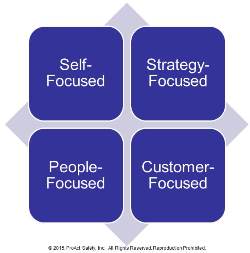Leading Through Difficult Times
Precision is necessary to ensure recovery with the right resources to rebound. If you must make cuts, use a scalpel, not an axe.
Lack of job security, new financial pressures, and business and economic disruption and uncertainty is today's reality for many organizations and the people within. Remaining positive and focused is a challenge for even the best leaders.
On the importance of leadership and leadership's primary role of influencing others, Antoine de Saint-Exupery, a French aviator and pioneer, once wrote, "If you want to build a ship, don't drum up the men to gather wood, divide the work, and give orders. Instead, teach them to yearn for the vast and endless sea." That's great advice when we are in a time of calm winds, no real time pressure, and when facing a certain future. But what about when the future is scary, jobs are uncertain, and clients are reducing investment? Not all leadership is collaboration and cajoling.
In working with organizations during the financial collapse of the last decade and the current challenges many are facing within the oil and gas industries, a mindset structure (4-Focused Leadership MindsetSM) was created to help guide leaders during the decisions that must be made when leading through difficult times.

Figure: 4-Focused Leadership MindsetSM
Self-Focused: Henry Ford emphasized, "When everything seems to be going against you, remember that the airplane takes off against the wind, not with it." Attitude is within; it can't be seen, but behaviors sure can. During difficult times, it is easy for leaders' behavior to reflect the worry they might be feeling about what they are personally going through and the potential uncertainty of the future. When a leader shows signs of worry, others worry. When the leader behaves with confidence, sureness can be solidified within others. If the leaders don't lead, the followers won't follow. Like the airline flight attendants suggest, "Put your oxygen mask on first before assisting others."
Strategy-Focused: Sun Tzu advised, "Strategy without tactics is the slowest route to victory. Tactics without strategy is the noise before defeat." If you are close to defeat, revisiting the strategy is vital. If you realize you merely have disconnected tactics without an overarching strategy focusing on value, creating it is priority one. Strategy is a framework of choices, tradeoffs, and small bets the organization makes to determine how to capture and deliver value. Strategy, therefore, is "How do we win?" It is hypercritical that a focus on immediate yet sustainable external and internal customer value becomes the central theme of decision-making. Also, it is easy to become short-sighted during financially difficult times to make across-the-board, indiscriminant reductions in headcount. Precision is necessary to ensure recovery with the right resources to rebound. If you must make cuts, use a scalpel, not an axe.
People-Focused: Philosopher Thomas Carlyle taught us, "No person was ever rightly understood until they had been first regarded with a certain feeling, not of tolerance, but of sympathy." As a leader, and depending on your level within the organization, you might know more about the current state than you can divulge. Your people need direction, confidence, empathy, encouragement, as well as transparent, sincere, and regular communication. Lacking all of this, it is to be expected that focus is lost and people will leave.
Great teams aren't formed as a result of team-building exercises, trust-falls or ropes courses. They form when they overcome adversity and collectively accomplish something. A strong leader is needed, one who enables transparency with people and provides comfort by forecasting what is needed to make it through, what the enablers or challengers are, and what resources are needed. A leader who continues with a "Don't bring me a problem without a solution" mentality will see few problems and few opportunities to facilitate a turnaround.
Customer-Focused: The Gartner Group found "95% of companies collect customer feedback. Yet only 10% use the feedback to improve, and only 5% tell customers what they are doing in response to what they heard." Mike Gospe, co-founder and principal of KickStart Alliance, warns, "Whoever understands the customer best wins." During difficult times, Gospe's advice could be modified to, "Whoever is closest and most positively stands out to the customer wins." Competing on cost is a dangerous strategy. Focus must be concentrated on delivering value and even creating surprising, unexpected value. This can't be accomplished unless you understand and get as close as practical to your customers, internally and externally.
All progress begins with thinking differently. It is this 4-Focused Leadership Mindset that has served many client leaders well. Focusing on yourself first might sound selfish, but if you aren't right mentally, you can't be an effective leader. Your people will need a different leadership style than they may have come to expect from you. You must become what is needed. This includes creating a different strategy and rallying and selling your team on why yours is the one to follow. But without knowing what the customer values and how you can differentiate and provide a competitive advantage, the strategy will fail. Most projects don't fail in the end, they fail in the beginning. It all starts with you and your mindset.
This article originally appeared in the October 2015 issue of Occupational Health & Safety.